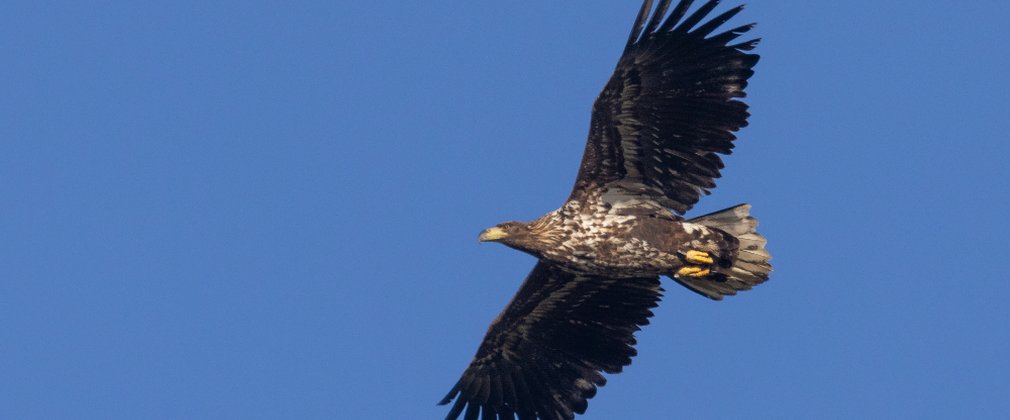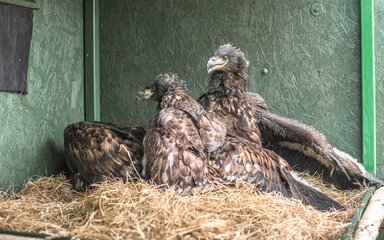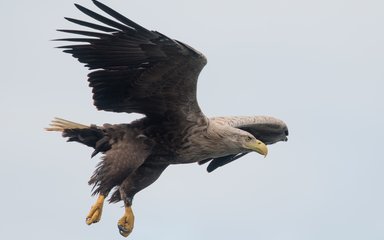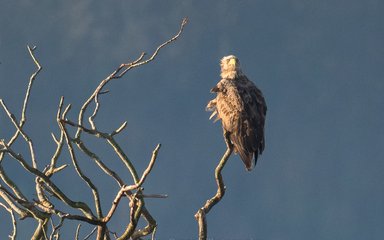
The white-tailed eagle, also known as the sea eagle, is the UK's largest bird of prey. Once widespread across the country, human persecution had wiped out the entire population by 1780. Today, they are one of the country's rarest species and are listed as a Bird of Conservation Concern.
White-tailed eagles were reintroduced to Scotland from the 1970s, and since 2019 we've been taking part in a landmark conservation project to return these incredible birds to England.
In 2019, working with the Roy Dennis Wildlife Foundation, we released the first six white-tailed eagles on the Isle of Wight, returning them after an absence of over 240 years. The project aims to restore these lost birds to the landscape by releasing up to 60 birds.
White-tailed eagle statistics
- length: between 70 and 90cm
- weight: males 3.5-5kg and females 4-7kg
- wingspan: an impressive 2-2.4m
- lifespan: 20-25 years

White-tailed eagle habitat and breeding
White-tailed eagles are found along rocky coastlines, estuaries and lochs near the sea - hence their alternative name of 'sea eagle'. Known as 'sit and wait' foragers, they are often sedentary, perching quietly in wooded areas and waiting for prey to come close. They eat fish, rabbits, hares and other birds.
White-tailed eagles mate for life and breed in the same territory each year. Mature eagles are extremely territorial and disputes can be fatal. The female lays two or three eggs in March or April and incubates them until they hatch after 38 days. The female does most of the direct feeding of the young, though the male will occasionally help. The chicks begin to feed themselves between five and six weeks of age, and fledge when they are about 10-11 weeks old.
Did you know? The size of a white-tailed eagle's nest is a big as a double bed!
What do white-tailed eagles look like?
White-tailed eagles have pale necks and heads, which become almost white in mature birds. Young birds have a mix of white and brown feathers, turning more brown as they mature.
As their name suggests, their tails are white and have a distinctive wedge shape. They have striking hooked yellow beaks, golden eyes and yellow legs.
The wings of white-tailed eagles are large and somewhat rectangular in shape, with distinctive fingered tips.


Eagle-eyed vision
White-tailed eagles have monocular and binocular vision allowing them to look sideways and straight ahead at the same time. They're able to see across huge distances and can spot features more than three miles away.
Eagles can distinguish more colours than the human eye, and they see in the UV range of light. This allows the birds to scan with greater definition, spotting potential prey, other eagles, and chart the changing landscape below them.
White-tailed eagle reintroduction project
White-tailed eagles were reintroduced to Scotland from the 1970s, and since 2019 we've been taking part in a landmark conservation project, with eagles translocated from Scotland, to return these incredible birds to England.
In August 2019, working with the Roy Dennis Wildlife Foundation, we released the first six white-tailed eagles on the Isle of Wight, returning them after an absence of over 240 years. The project aims to restore these lost birds to the landscape by releasing up to 60 birds over the project's life.

